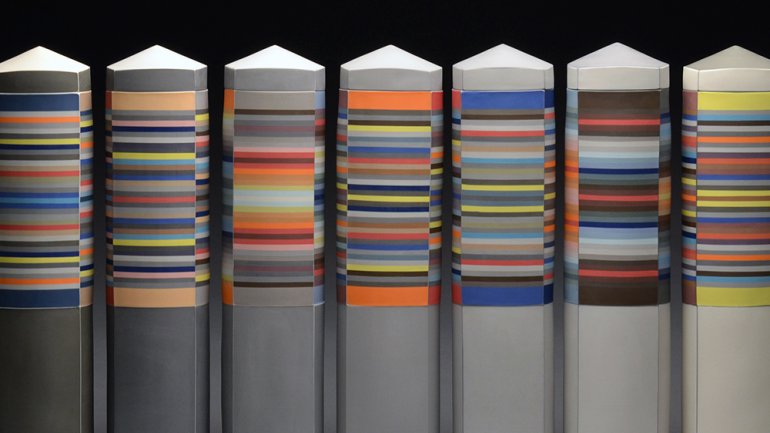Pincus' 12-Step Process
Pincus' 12-Step Process
After years of experimentation, Peter Pincus has devised the following recipe for patterned porcelain vessels. Essentially, it’s as if he brushes layers and layers of paint on a canvas, and when the paint is dry, peels away the canvas, leaving a freestanding painting.
He offers these instructions freely – but with a warning: Each step (based on a typical urn) entails a plethora of substages, tools, and materials. “Every stage is tedious and laborious and long,” Pincus says. “It’s a beast.” And not a lucrative beast, either, as you can see by the time required (and the perhour profit, revealed at the end).
1. Templating / 3 hours
Sketch vessel shapes until the perfect “icon” emerges. Translate the form into separate segments (for example, foot, body, and finial). Examine, tweak, and convert into cardboard cutouts.
2. Moldmaking / 30-50 hours
Begin by throwing a stoneware vessel on the wheel, pausing often to measure the form against the cardboard template. Put a collar of aluminum flashing around the clay piece, sealing it to the wheel with a thick gusset of plaster. Mix up more plaster, and pour it into the void as the wheel spins.
When the plaster is hardened, peel the stoneware clay out of the new mold and smooth its interior. Mark angled cuts, then slice the mold into pieces with a band saw, discarding portions to create a narrower, enhanced form. Smooth the remaining plaster pieces against a block of sandblasted glass until they fit perfectly together. Cast top and bottom plates out of plaster to finish the mold. Repeat for the other segments.
3. Drying / 1 to 3 days
To ensure the mold pieces are dry so they can absorb moisture from the slip, arrange on a table between blasting fans.
4. Color work / 10 hours
Prepare the color palette by mixing powdered mason’s stains with porcelain slip. Take a piece of the mold, and pour or brush on the first color.
When the slip has dried to the texture of skin, scrape off the excess from the sides and back of the mold section. Using an X-Acto knife, cut through the slip to designate the color’s edge. Peel off the excess slip, sponge the mold surface, and apply the next color. Repeat until you have the desired layers and patterns.
When the colored slip is all dry, fit the mold sections together and secure them with straps. Fill the mold with more porcelain slip, and let it sit for 20 minutes, so the plaster absorbs moisture and a layer of porcelain fuses to the skin of tinted slip.
Pour out that final slip, and let what remains dry. Unband the mold, and carefully remove it for future use. Trim and smooth the form.
5. Bisque firing / 16 hours
Fire the forms at 1,888º F.
6. Wet sanding / 3 hours
When the pieces are cool, smooth any rough spots with wet sandpaper.
7. Glazing / 30 minutes
Apply a coat of clear glaze to the interiors (and any exterior surfaces that will have luster).
8. Firing / 9 hours
Fire the pieces again, this time at 2,250 degrees F.
9. Lustering / 4 hours
When the pieces are cool, brush the designated sections with syrup-like gold glaze. Fire them – one last time – at approximately 1,300 degrees.
10. Sanding / 30 minutes
Smooth any rough surfaces using wet sandpaper.
11. Gluing / 2 hours
Fasten the urn’s segments together with marine-grade epoxy. After the glue cures for a day, sand the junctures, tape them off, and rub in a coat of tinted epoxy – as if applying caulk – to ease the transition between the glued parts.
12. Finishing / 1 to 2 hours
Once again, sand and sand.
Pincus figures that – after accounting for expenses, from materials and employee salaries to shipping and gallery commissions – he earns between $15 and $20 an hour. Asked why he doesn’t patent his process, he replies, “You would have to be crazy to choose to do this for a living.”

